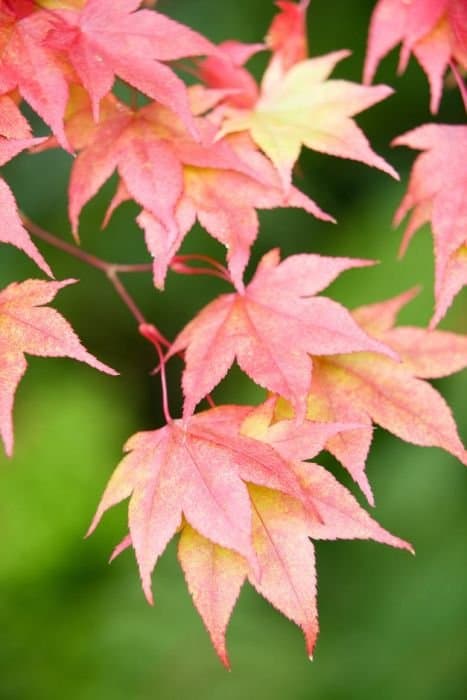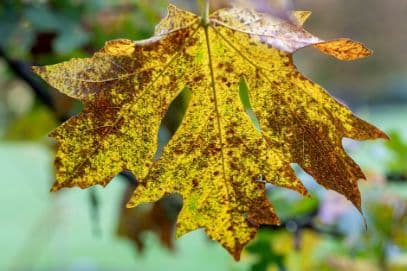Korean maple Acer pseudosieboldianum

ABOUT
Acer pseudosieboldianum, commonly known as the Korean maple, is a plant with a visually striking appearance. The Korean maple showcases leaves similar to those of a classic maple, with a palmate shape that typically sports nine to eleven sharply pointed lobes, resembling an open hand with outstretched fingers. The leaves display a bright and lush green color during the growing season, turning into a spectacular range of yellows, oranges, and reds in the fall, providing a dramatic and colorful display in the garden. The flowers of the Korean maple are less conspicuous, with small clusters emerging in spring that appear yellowish or cream-colored. These blooms give way to winged seeds, much like those found on other maple varieties, which mature in late summer to early fall, starting green and transitioning to brown as they ripen. The bark adds further interest, particularly in the winter, with its smooth and grayish facade, sometimes showing a more exfoliating texture as the plant matures. Overall, the Korean maple's layered branching structure and attractive foliage make it a beloved choice for ornamental use among garden enthusiasts looking for a tree with delightful year-round appeal.
About this plant
 Names
NamesFamily
Sapindaceae.
Synonyms
Korean Maple, Purplebloom Maple, Pseudo-Siebold Maple.
Common names
Acer pseudo-sieboldianum (Pax) Kom., Acer takesimense Nakai
 Toxicity
ToxicityTo humans
Korean maple, the common name for Acer pseudosieboldianum, is not commonly known for being toxic to humans. There are no well-documented cases or studies indicating that this plant poses a significant risk upon ingestion. However, it's always prudent to exercise caution and avoid eating plants not established as safe for consumption, as individual reactions can vary.
To pets
Korean maple is generally not considered toxic to pets. There are no prominent reports or clinical evidence suggesting that ingestion of this plant by pets, such as dogs or cats, is harmful. Nonetheless, pets should be discouraged from chewing on plants since non-toxic plants can sometimes cause mild stomach upset due to the consumption of plant material that they are not adapted to digest.
 Characteristics
CharacteristicsLife cycle
Perennials
Foliage type
Deciduous
Color of leaves
Green
Flower color
Varies
Height
15-25 feet (4.6-7.6 meters)
Spread
15-20 feet (4.5-6 meters)
Plant type
Tree
Hardiness zones
4
Native area
Korea
Benefits
 General Benefits
General Benefits- Ornamental Value: Acer pseudosieboldianum, commonly known as the Korean maple, is appreciated for its aesthetic appeal due to its vibrant foliage colors and attractive growth habit, making it a popular choice for gardens and landscapes.
- Shade Provision: The Korean maple can provide shade in gardens and parks due to its broad canopy, which can enhance outdoor comfort during sunny days.
- Habitat for Wildlife: It serves as a habitat for various species of wildlife, including birds and insects, which find refuge and food amongst its branches.
- Seasonal Interest: With its striking leaf colors that change with the seasons, Acer pseudosieboldianum adds year-round interest to outdoor spaces, particularly with its vivid autumn coloration.
- Drought Tolerance: Once established, Korean maples are relatively tolerant of drought conditions, which can be beneficial in areas susceptible to water scarcity.
- Soil Erosion Control: The root system of the Korean maple helps in stabilizing soil, which can prevent erosion in hilly or sloped areas within its hardiness zones.
 Medical Properties
Medical PropertiesThis plant is not used for medical purposes.
 Air-purifying Qualities
Air-purifying QualitiesThis plant is not specifically known for air purifying qualities.
 Other Uses
Other Uses- As a bonsai tree: Acer pseudosieboldianum, commonly known as Korean maple, can be pruned and trained to create a miniature bonsai display, taking advantage of its attractive foliage and branch structure.
- In landscape designs: Korean maple is featured in garden designs for its vibrant autumn color display, adding aesthetic value to parks and home gardens.
- As a shade provider: Due to its broad canopy, the Korean maple serves as a natural shade source in gardens and patio areas.
- In art and photography: The tree's unique appearance, especially during the fall, makes it a popular subject for nature photographers and artists.
- For educational purposes: It can be used in botanical gardens and arboreta to educate visitors about plant biodiversity and different species of maples.
- In woodworking: Wood from the Korean maple can be crafted into small wooden items such as bowls, trays, or decorative objects.
- As a living fence: When planted in a row, the Korean maple can form a living fence or privacy screen for property boundaries.
- Dye production: The leaves might be used to produce natural dyes for fabrics or crafts, although usage might not be widespread.
- Culinary decoration: While not commonly known for edible uses, leaves could potentially be used for plate decoration or garnishes in high-end culinary presentations.
- As a symbol: In some cultures, maple trees might hold symbolic meanings and the Korean maple could be incorporated into cultural or religious ceremonies accordingly.
Interesting Facts
 Feng Shui
Feng ShuiThe Korean maple is not used in Feng Shui practice.
 Zodiac Sign Compitability
Zodiac Sign CompitabilityThe Korean maple is not used in astrology practice.
 Plant Symbolism
Plant Symbolism- Resilience: Acer pseudosieboldianum, commonly known as Korean maple, symbolizes resilience due to its ability to withstand cold temperatures and harsh climates, reflecting the ability to endure and adapt to challenging conditions.
- Strength: The sturdiness and solid structure of the Korean maple represent strength and stability, often inspiring individuals to embody these qualities in their own lives.
- Beauty: With its stunning fall colors, the Korean maple is often associated with beauty and aesthetic appreciation, reminding us of the visual splendors of nature.
- Change: As a deciduous tree that changes color with the seasons, the Korean maple is also a symbol of change and transformation, signifying the transient nature of life and the beauty of embracing new phases.
- Peace: The soft, calming appearance of the Korean maple's foliage can evoke a sense of peace and tranquility, offering a symbolic representation of calm in one's surroundings and within oneself.
 Water
WaterThe Korean maple, which is the most common name for Acer pseudosieboldianum, prefers consistent moisture, particularly during the growing season in spring and summer. Water the tree deeply once a week, providing approximately 1.5 gallons for young trees and increasing to 2 to 3 gallons for more established trees, depending on the size and environmental conditions. During the hot months, watering may need to be increased, especially for trees in full sun. In the dormant season (fall and winter), reduce the frequency of watering, but do not allow the soil to completely dry out. Ensure proper drainage to avoid waterlogging which can lead to root rot.
 Light
LightThe Korean maple thrives best in full to partial sunlight. An ideal location would offer morning sunlight and afternoon shade, particularly in areas with hotter summers. However, the tree is versatile and can tolerate a range of light conditions, though too much shade can inhibit its growth and fall color display.
 Temperature
TemperatureKorean maples are adaptable to a range of temperatures and can withstand winter cold down to -20°F, making them suitable for zones 4 through 7. The ideal growing temperature range for this maple is between 60°F and 70°F. Sudden temperature fluctuations or extreme heat above 90°F can cause stress to the plant.
 Pruning
PruningPruning the Korean maple should be done to maintain its shape, remove any dead or diseased wood, and encourage healthy growth. The best time to prune is in the late winter or early spring before new growth starts, although light pruning can also be done in summer if necessary. Pruning every 2 to 3 years is often sufficient, focusing on thinning out overcrowded branches to improve air circulation and light penetration.
 Cleaning
CleaningAs needed
 Soil
SoilKorean Maple thrives in well-draining, slightly acidic soil with a pH of 5.5 to 7.5. A mix of loam, sand, and organic matter such as peat or compost is ideal to ensure adequate nutrition and drainage.
 Repotting
RepottingKorean Maples in containers should be repotted every 2-3 years to prevent root-bound conditions and replenish nutrients in the soil.
 Humidity & Misting
Humidity & MistingKorean Maple prefers moderate humidity levels; too low can cause leaf problems, but it's adaptable to average outdoor conditions.
 Suitable locations
Suitable locationsIndoor
Place Korean Maple in bright, indirect light and ensure adequate humidity.
Outdoor
Plant in well-draining soil, partial sun, and protect from harsh winds.
Hardiness zone
4-7 USDA
 Life cycle
Life cycleThe Korean maple (Acer pseudosieboldianum) life cycle begins with seed germination, typically occurring in spring when soil temperatures rise. Following germination, the seedling stage is characterized by the development of a basic root system and the first true leaves, which allow for photosynthesis. As the sapling matures, it undergoes a period of vegetative growth, developing a woody stem, branches, and a more complex root network. After reaching maturity, which can take several years, the Korean maple produces flowers, which are usually small and inconspicuous, followed by the development of its characteristic winged fruits known as samaras. These samaras are dispersed by wind, allowing for the spread of the species. The mature tree can then continue to grow and reproduce annually, typically enjoying a lifespan that can extend over several decades.
 Propogation
PropogationPropogation time
Early spring
Korean maple (Acer pseudosieboldianum) is most commonly propagated through seed collection and sowing. The best time to collect seeds is in the fall after they have matured and have a brownish color. Sow the seeds immediately in the fall in a cold frame or wait until the spring after stratifying them throughout the winter. Stratification involves mixing the seeds with slightly moistened sand or vermiculite and storing them in a sealed bag in the refrigerator for 90 to 120 days. Once stratified, seeds can be sown about 1/4 inch deep in well-draining, fertile soil. They usually germinate in the spring with the warmth and increased daylight. The seedlings will require at least one growing season before they can be transplanted to their final location.








![Shirasawa maple [Moonrise]](/_next/image?url=https%3A%2F%2Fplants-admin.emdemapps.com%2Fimages%2Fplants%2F%2Fimages%2F604b5dde58337.png&w=640&q=75)